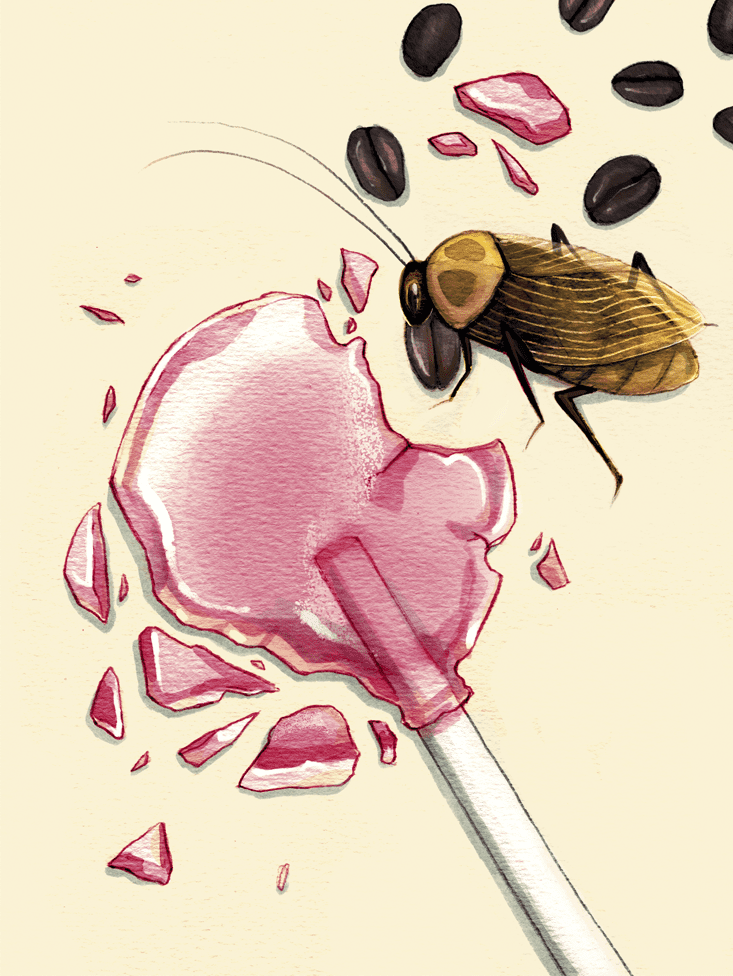Bitterness functions like an alarm blaring, “Beware!” Its wretched1 taste can repulse, but also rescue, as with a roach population whose survival has befuddled exterminators since 1987. That’s when Jules Silverman, an entomologist at a New Jersey-based company that made insect bait, began to receive boxes of live cockroaches that hadn’t been killed by the company’s glucose-laced bait.
Silverman found that the surviving roaches refused to touch glucose. The roach colonies he reared in the lab, on the other hand, readily ate the simple sugar—as did most roaches in the wild. Yet it wasn’t for another 20 years, when he was at North Carolina State University, that he discovered why that was. A mutation had apparently altered some “taste genes” so that the insects tasted glucose as bitter. As Silverman’s collaborator on the study, a North Carolina State entomologist named Coby Schal, put it, “If you had this mutation, glucose would taste like coffee, really strong coffee. You would spit it out.”
Roaches with altered taste receptor genes avoided the baits used by exterminators and survived, while their unchanged counterparts fell for the sweet, poisoned bait. Within about five years, or 25 cockroach generations, the tastes of the region’s roach population had changed.
Almost all animals have multiple genes responsible for receptors that detect various shades of bitterness.
Taste can be a matter of life or death for animals. The taste sense can be traced back to proteins in one-celled organisms, which must determine which chemicals can safely slide through their membranes and which must be blocked. Other proteins in animals serve a similar function. They’re found in the taste hairs (or sensilla) in cockroaches, and in the taste buds on human tongues. When a sweet or savory substance binds to protein receptors lining these structures, the corresponding receptor sends a message to the brain. The roach study demonstrated that the “taste genes” encoding each receptor can shift under dietary pressure: A chemical the roaches once perceived as sweet now tastes bitter.
Most animals respond to bitterness in an obvious way—by gagging, grimacing, vomiting, or avoiding the food altogether. Presumably this near-universal aversion evolved over millions of years as insects and other animals that lacked an ability to sense bitter, toxic compounds in plants died. Meanwhile, those that had the genes to encode bitter taste receptors survived and passed those genes on to the next generation. Today, almost all animals have multiple genes responsible for receptors that detect various shades of bitterness. Humans, for example, have around 30.

Taste genes can evolve quickly in a population who will otherwise die by, say, sugary bait. However, nature rarely culls an entire group of animals so swiftly. Sarah Tishkoff, a geneticist at the University of Pennsylvania, decided to see how much bitter taste genes have changed within humans over evolutionary time. Her team has found evidence that the genes associated with bitter tasting may have arose about a million years ago—long before modern humans existed—and were passed down through the ages. Yet human populations have subsisted on different types of plants for hundreds of thousands of years, and Tishkoff wondered if the ability to detect certain bitters varied with their diets.
To test the idea, Tishkoff compared the gene encoding a receptor that senses a bitter substance found in broccoli (called phenylthiocarbamide, or PTC) among 57 African populations who had long subsisted on various hunter-gatherer and agricultural diets. Contrary to her expectation, she discovered that the genetic sequences of the PTC-sensing genes remained similar between the groups. Such stability indicates that the gene is under pressure to not change because it serves some vital purpose. Detecting PTC’s bitterness was evidently not the gene’s only function.
Tishkoff and her team now suspect the gene serves a biological purpose beyond taste. “We think these taste perception genes have important physiological roles,” she says. Indeed, bitter taste receptors occur on cells lining the nose, intestine, and airways. In these places, the receptors sense bitter-tasting compounds, but send a cue unrelated to taste to the body. Tishkoff speculates that signal might associate bitter tasting compounds with positive internal processes, like an immune attack against an infection, or a negative one. In other words, the genes that control for bitterness might stretch far beyond the tip of our tongues. The proteins they encode may perform functions completely unrelated to digestion.
Our adult flirtations with bitterness already hint that there may be more to predilections than taste. Rather than creep away from bitter bait like cockroaches, foodies scurry toward it. Mixologists craft bitter cocktails. Gourmet restaurants offer chicory, Swiss chard, and arugula salads, and beer aficionados relish double-hopped India pale ale. Nigerians flavor food with dried bitter leaf and Chinese recipes call for bitter melon. People around the world learn to like bitter foods and drinks after experiencing the feeling of eating them. A flavor that once served as a warning might now signal something else.
Peter Andrey Smith is a Brooklyn-based freelance journalist.



